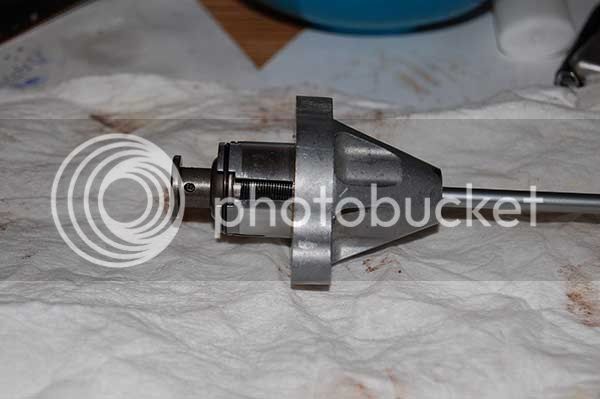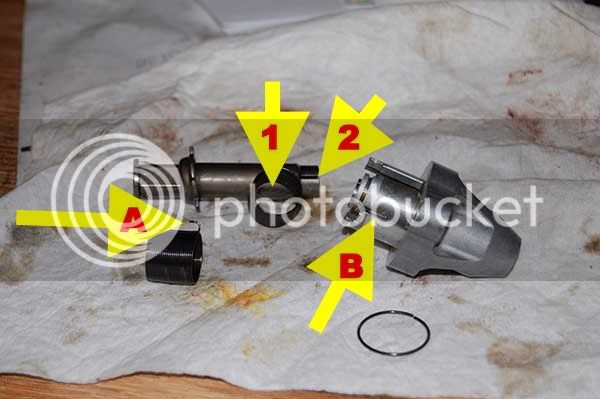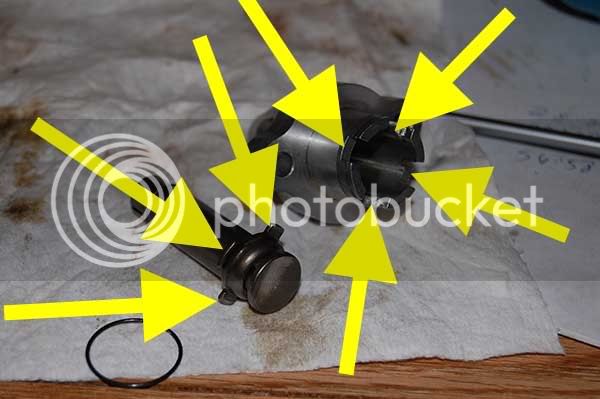Figured out what the problem was....(in Italian dialect) "She'sah brokeahno feex!"
What the hell do I have to lose...tear the mother apart and see how she works.
When you turn the "adjustment screw" accessed through the exterior bolt hole, you screw the plunger IN to the plunger body. This action winds up the "clockwork" spring so that when released, the spring unwinds and "unscrews" the plunger OUT to contact the chain slipper.
As Ionbeam has noted in other threads, the amount of tension on the spring controls how actively and forcefully the plunger extends to contact the chain slipper. The plunger basically won't retract on its own, since the only way it CAN retract is to be screwed in to the plunger body against spring tension. I don't see how this can happen under any condition. There is no need for a pawl or ratchet system to keep the plunger extended...it simply can't retract unless you turn the screw from the exterior of the CCT body.
HOWEVER!!!
Get ready for some fun:
Arrow 'A' points to the little tang at the top of the spring insde the housing that locks into slot 'B' on the exterior of the housing.
Arrow '1' points to the "crossmember" at the base of the spring that fits into slot '2' on the plunger shaft.
So when the CCT is assembled, when you screw the plunger IN to the plunger body, you wind up the spring. Release the screw and the spring unwinds, screwing the plunger back out.
There's just ONE LITTLE BITTY PROBLEM with my CCT.....note the two springs in the picture? 'A' and '1'?
They should be 1 spring! Cleanly broken as Bluesey opined. So NO extension. As the chain wore, there was NO plunger movement at all, so the slipper simply had NO effect on chain tension. Chain became SO loose, it started whipping around on the "return" run from the crank sprocket to the intake cam sproket. Hence all the racket.
Also, there is also NO effect by oil pressure on the mechanism. It's spring tension
only to extend the plunger.
My plunger moves smooth as silk. There's just no spring to MAKE it move. And contrary to what Ionbeam wrote in his disaster thread, the tabs that locate the plunger body in the CCT housing, noted here with arrows: (you can't see one of the tabs on the plunger body from the picture angle)
CAN be rotated 180 degrees, rather than only 360 degrees that Ionbeam had noted in his thread, so should one have a CCT with weak return tension, the circlip can be easily removed, the plunger "cap" with the tabs rotated 180 degrees to add tension, then the circlip replaced.
Now is this something one SHOULD do? I'll leave that for gods and demons to debate. But a weak plunger spring CAN be tensioned more with a simple 180 degree turn of the plunger cap in the housing. I'm sure there's a point of diminishing returns where the spring would bind, but YMMV.
The simple reason so many have reported quieting down their noisy motors with a quick trip to the dealer, the tech simply screws the plunger out a little tighter against the chain slipper. If this has happened to your FJR, that means your spring doesn't have enough tension on it to screw the plunger out by itself. Given a few more 10k miles, it gets noisy again, adjust it again. It really works in concept just like a manual CCT, except there's a little clockwork spring doing the adjusting for you.
Personally I find it nearly incomprehensible that the life of the engine is left in the hands of ONE tiny little spring.
In reality, all I need to fix my CCT is a replacement spring. The rest of the mechanism operates smoothly, has no damage, scuffs or wear marks. There's just no way for the plunger to extend with the spring in two pieces.
The $64,000 question remains....did I shut it down in time and avoid a skipped tooth/piston/valve collision. Tomorrow will tell when I yank the cams.
Edit: I see above Alan mantions you CAN adjust spring tension by rotating the cap, as I discovered. He just recommends you DON'T. Again, this might be a matter for debate, but I'm in no position to know, since my spring is busted. But would I if my spring was only weak and not broken? I might try it, but then I'd worry about it every time I cranked up my bike.














